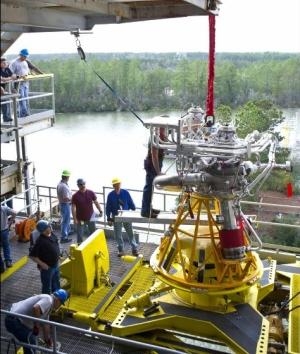Fri, Jan 27, 2012
First New 'Human Rated' Engine To Be Developed In Four
Decades
A new series of tests on NASA's new J-2X engine will begin next
week at NASA's Stennis Space Center in southern Mississippi. NASA
says the tests on the engine bring it one step closer to the first
human-rated liquid oxygen and liquid hydrogen rocket engine to be
developed in 40 years.

Tests will focus on the powerpack for the J-2X. This
highly efficient and versatile advanced rocket engine is being
designed to power the upper stage of NASA's Space Launch System, a
new heavy-lift launch vehicle capable of missions beyond low-Earth
orbit. The powerpack comprises components on the top portion of the
engine, including the gas generator, oxygen and fuel turbopumps,
and related ducts and valves that bring the propellants together to
create combustion and generate thrust. "The J-2X upper stage engine
is vital to achieving the full launch capability of the
heavy-lift Space Launch System," said William Gerstenmaier, NASA's
associate administrator for the Human Exploration and Operations
Mission Directorate. "The testing today will help ensure that a key
propulsion element is ready to support exploration across the solar
system."
About a dozen powerpack tests of varying lengths are slated now
through summer at Stennis' A-1 Test Stand. By separating the engine
components -- the thrust chamber assembly, including the main
combustion chamber, main injector and nozzle -- engineers can more
easily push the various components to operate over a wide range of
conditions to ensure the parts' integrity, demonstrate the safety
margin and better understand how the turbopumps operate.
"By varying the pressures, temperatures and flow rates, the
powerpack test series will evaluate the full range of operating
conditions of the engine components," said Tom Byrd, J-2X engine
lead in the SLS Liquid Engines Office at NASA's Marshall Space
Flight Center in Huntsville, Ala. "This will enable us to verify
the components' design and validate our analytical models against
performance data, as well as ensure structural stability and verify
the combustion stability of the gas generator."
This is the second powerpack test series for J-2X. The powerpack
1A was tested in 2008 with J-2S engine turbomachinery originally
developed for the Apollo Program. Engineers tested these heritage
components to obtain data to help them modify the design of the
turbomachinery to meet the higher performance requirements of the
J-2X engine. "The test engineers on the A-1 test team are excited
and ready to begin another phase of testing which will provide
critical data in support of the Space Launch System," said Gary
Benton, J-2X engine testing project manager at Stennis.
More News
Airbus Racer Demonstrator Makes Inaugural Flight Airbus Helicopters' ambitious Racer demonstrator has achieved its inaugural flight as part of the Clean Sky 2 initiative, a corners>[...]
A little Bit Quieter, Said Testers, But in the End it's Still a DA40 Diamond Aircraft recently completed a little pilot project with Lufthansa Aviation Training, putting a pair of >[...]
Line Up And Wait (LUAW) Used by ATC to inform a pilot to taxi onto the departure runway to line up and wait. It is not authorization for takeoff. It is used when takeoff clearance >[...]
Contributing To The Accident Was The Pilot’s Use Of Methamphetamine... Analysis: The pilot departed on a local flight to perform low-altitude maneuvers in a nearby desert val>[...]
From 2015 (YouTube Version): Overcoming Obstacles To Achieve Their Dreams… At EAA AirVenture 2015, FedEx arrived with one of their Airbus freight-hauling aircraft and placed>[...]
 Airbus Racer Helicopter Demonstrator First Flight Part of Clean Sky 2 Initiative
Airbus Racer Helicopter Demonstrator First Flight Part of Clean Sky 2 Initiative Diamond's Electric DA40 Finds Fans at Dübendorf
Diamond's Electric DA40 Finds Fans at Dübendorf ANN's Daily Aero-Term (04.23.24): Line Up And Wait (LUAW)
ANN's Daily Aero-Term (04.23.24): Line Up And Wait (LUAW) NTSB Final Report: Extra Flugzeugbau GMBH EA300/L
NTSB Final Report: Extra Flugzeugbau GMBH EA300/L Classic Aero-TV: 'Never Give Up' - Advice From Two of FedEx's Female Captains
Classic Aero-TV: 'Never Give Up' - Advice From Two of FedEx's Female Captains



